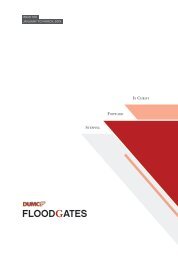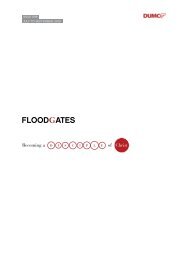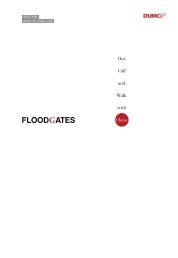Floodgates 101_Issue2_2019_FINAL
You also want an ePaper? Increase the reach of your titles
YUMPU automatically turns print PDFs into web optimized ePapers that Google loves.
Features<br />
The plot of the parable<br />
the man from Jerusalem<br />
Jerusalem<br />
Jericho<br />
The robbers<br />
stripping of the man<br />
beating of the man<br />
leaving the man half dead<br />
the priest<br />
the Levite<br />
the Good Samaritan<br />
binding the man’s wounds<br />
the oil<br />
the wine<br />
the donkey<br />
the inn<br />
the two denarii<br />
the innkeeper<br />
the return of the Good Samaritan<br />
Adam<br />
Augustine’s allegorical representation<br />
City of Heavenly Peace<br />
mankind's mortality<br />
the devil and his angels<br />
taking away his immortality<br />
persuading him to commit sin<br />
due to sin, the man should have been dead<br />
spiritually but was nonetheless kept half alive<br />
due to his knowledge of God<br />
priesthood of the Old Testament, the Law<br />
ministry of the Old Testament, the Prophet<br />
Jesus Christ<br />
a restraint had been placed on sin<br />
comfort of good hope<br />
exhortation to spirited work<br />
the body of Jesus Christ<br />
the church<br />
the two commandments of love<br />
Apostle Paul<br />
the resurrection of Jesus Christ<br />
Augustine’s approach of an over-allegorical<br />
interpretation of the Parable of the Good<br />
Samaritan is certainly inaccurate.<br />
THE SANDWICHED REFERENCE TO<br />
ISAIAH 6:9-10<br />
Jesus’ reference to Isaiah 6:9-10 here may<br />
come across as rather harsh as His disciples<br />
had merely asked for clarity on this parable.<br />
But if Isaiah 6:9-10 is understood within<br />
its larger context in the Old Testament<br />
storyline, not only do we see its relevance,<br />
but we are also given a better understanding<br />
of The Parable of the Sower and its place<br />
in the New Testament, as well as why, out<br />
of the four sowing attempts, only one was<br />
successful.<br />
In Isaiah 6, we find the Kingdom of Judah<br />
in desolation after King Uzziah’s death. To<br />
alleviate the state of Judah, the prophet<br />
Isaiah had met with the Lord and had availed<br />
himself to the Lord’s service – it is here we<br />
find Isaiah’s well-known words “Here I am<br />
[Lord]. Send me!” (Isaiah 6:8). Studies on<br />
Isaiah 6 commonly stop here and fail to<br />
realise that the weight of the Lord’s<br />
command comes after this verse.<br />
He said, “Go and tell this people: ‘Be<br />
ever hearing, but never understanding;<br />
be ever seeing, but never perceiving.’<br />
Make the heart of this people calloused;<br />
make their ears dull and close their eyes.<br />
Otherwise they might see with their<br />
eyes, hear with their ears, understand<br />
with their hearts, and turn and be<br />
healed.” Then I said, “For how long,<br />
Lord?” And he answered: “Until the<br />
cities lie ruined and without inhabitant,<br />
until the houses are left deserted and<br />
the fields ruined and ravaged, until the<br />
Lord has sent everyone far away and the<br />
land is utterly forsaken. And though a<br />
tenth remains in the land, it will again be<br />
laid waste. But as the terebinth and oak<br />
leave stumps when they are cut down,<br />
so the holy seed will be the stump in the<br />
land.”<br />
Isaiah 6:9-13<br />
27







